1. Body cleanliness
2. Good health
3. Clean environment
4. Proper use of medicine
5. Proper storage of medicine
- Body cleanliness means making sure your body is kept clean at all times.
- The whole body needs to be cleaned and not just certain specific parts of the body.

- The hair, eyes, ears, nose and mouth are all parts of the head.
- They should be cleaned regularly.
- Cleaning the nose using a handkercheif,
NB: Cleaning the ear can be dangerous and care to use the right material and procedure is important. Ask your teacher to show you how to clean the ears.
- Let’s have a closer look at how and why you should clean these parts regularly including teeth.
- Hair grows where there are oil-producing cells in the body.
- The oil is sticky and is good at attracting and catching dust.
- To keep the hair and the skin of the head (scalp) clean, you should clean your hair regularly.
- The hair should be washed with soap and warm water.
- It should then be dried with a clean dry towel.
- The hair should then be combed using a brush or comb, to make it look tidy.
- Cleaning the hair regularly ensures that the head does not become a breeding ground for external parasites such as lice.
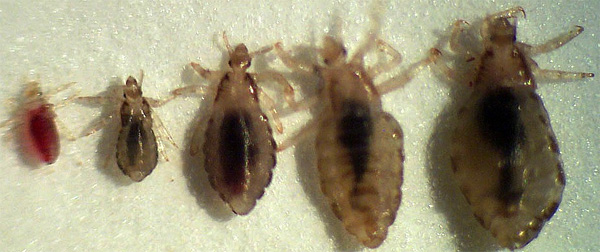
- The face should be washed at least two times a day; in the morning and in the evening.
- The face should be washed with a face towel and soap and warm water preferably.
- This opens up the oil and sweat pores on the skin enabling the skin to be clean and fresh.
- It also washes away any dust particles that stick to the face blocking these pores.
- The face towel should be used to gently rub the face.
- The face should then be rinsed with clean warm water, then dried with a towel.
- The mouth has the tongue, teeth and gums.
- The mouth should be cleaned regularly.
- It should be cleaned in the morning and every time you have a meal.
- By cleaning the mouth any remains of food particles and living things (bacteria) in the mouth are washed away.
- The teeth, tongue and gums should be cleaned using a toothbrush and toothpaste.
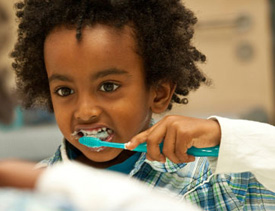
- The limbs include the arms and the legs.
- The parts of the arms (hands and nails) are more likely to come into contact with dirt.
- They are often used when working or eating.
- The hands should be cleaned with clean warm water and soap.
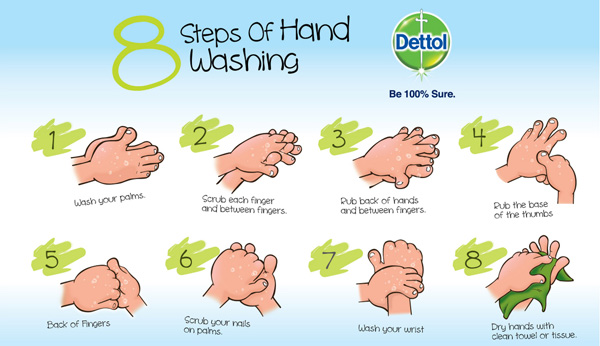
- When we wash the whole body, we say we are taking a bath or a shower.
- In cleaning the other parts of the body, use a clean face towel or a sponge that is well lathered with soap.
- The skin should be scrubbed gently using the lathered sponge or face towel.
- Special attention should be given to the armpits, the neck and the groin (between the legs).
- These parts are hidden and they sweat more. They should therefore be cleaned well.
- Hair in the armpits should be shaved to reduce sweating and bad smell around the armpit.
- The body should then be rinsed properly and wiped with a clean dry towel.
- One should take a bath every day.
- After a bath, one should put on clean underwear and clean clothes.
- What are personal items?
- Personal items are your private things that are essential for your hygiene, grooming and good health.
- Personal items include handkerchief,hair-comb, hairbrush, toothbrush, socks and towel.
1. Personal items should always be kept clean. They should be washed with warm water and soap. Handkerchiefs, underwaer, towels and socks should then be spread on the clothesline to dry.
2. Combs and hairbrushes can be cleaned by wiping them using a wet piece of cloth.
3. A Toothbrush should be cleaned by immersing it in warm water. This should be done regularly after use.
4. Personal items should not be shared. They can transmit skin diseases such as ringworms from one person to another.
- Personal cleanliness contributes towards proper hygiene and good health.
Personal items include:
Can you think of any more?
- Different people experience different forms of health.
- Some people are often ill and are said to have poor health.
- Those people who rarely get sick have good health.
- People in good health easily recover from minor illnesses.
- Their bodies can easily fight the disease causing organisms.
- People with poor health have good health if they took care of themselves more carefully.
For one to have a good health, the body requires the following:
Let’s explore these requirements in more detail.
The food that we eat must be clean, adequate and should be a balanced diet.
By being adequate, the food must be eaten in enough quantities to supply the required nutrients that the body needs.
The food should have all the essential nutrients, namely: carbohydrates, proteins, fats, vitamins and mineral salts.
These nutrients can be found in the following foods:
1. Carbohydrates.
Carbohydrates provide energy to the body.
The energy is used for doing work.
Carbohydrates are found in foods such as rice, sugar, maize, potatoes, groundnuts, wheat, ugali or bread.
2. Proteins
Proteins are used in the body for:
• Body repair. They help repair worn out body tissues.
• Body building and growth.
They protect the body from diseases.
They contain more vitamins and minerals.
We get vitamins and minerals from foods such as vegetables and fresh fruits.
In order to have strong and healthy teeth, we need the mineral called calcium.
For our blood to carry oxygen, we need the mineral called iron.
Iron helps in forming the red blood cells that carry oxygen.
Absence of iron leads to shortage of red blood cells, a disease called anaemia.
We can also get a type of vitamin called vitamin D from sunlight.
The absence of vitamin D causes a disease called rickets.
Food containing all these nutrients is said to be a balanced diet.
After an adequate balanced meal we should take plenty of water, preferably six to eight glasses per day about two litres of water per day.
Exercise helps the body to maintain good health.
The body therefore needs to be exercised regularly.
Exercising through games, athletics and physical education is good because:
1. It strengthens muscles and improves flexibility making movement easier.
2. It helps in developing good body posture. This helps muscles to hold the body in a natural position when one is standing, walking or sitting.
3. It burns body fat. Excess body fat may bring about heart disease.
4. Exercise trains or conditions the heart to beat regularly at a better pace and makes the heart stronger.
5. It also helps to develop the lungs.
Regular medical checkup is helpful in identifying a problem that may be prevented.
When one is sick, administration of drugs can check the disease and if the disease is diagnosed in the early stages, it can be cured or managed much better.
A good example is HIV/AIDS.
If the disease is diagnosed early enough, and the patient follows the instructions and takes medicine as prescribed by the doctor, the patient can live much longer.
It is important to take medicine as instructed by the doctor.
To keep in good health we should:
1. Take medicine as recommended by the doctor.
2. Not take medicine meant for another person even if you are suffering from a similar disease.
3. Not to prescribe medicine for ourselves.
Without sleep the body becomes tired and makes one unable to do anything of value.

• It makes a tired body feel fresh again.
• After sleep, the energy in the body is regenerated. The muscles regenerate their strength and are ready to work again.
• A tired mind or brain refuses to take in new things, so sleeping makes the mind sharp and ready to learn again.
This table shows the recommended time for human beings to sleep.
Age Sleeping period
1-2 yrs 16 hrs
2-5 yrs 14 hrs
6-9 yrs 12-13 hrs
10-18 yrs 9-11 hrs
Adults 8 hrs minimum sleeping time
After working all day or after playing, the body gets tired.
The body must be allowed time to refresh.
For good health we need to rest so that:
• The body may regain its strength. After rest, a tired body is ready for work again.
• The food that has been eaten is easily digested.
• The body is able to remove wastes which may affect its functionality.
• The mind becomes refreshed.
Environment means all that is around us.
When we are at school, our environment includes everything that is within the school compound.
The school should be kept clean and tidy.
Let’s have a look at which parts of the school we can help keep clean.

The paths in the compound must be swept, the flower beds weeded and the grass cut or trimmed.
Rubbish collected should be disposed off either in a dustbin or in a rubbish or garbage pit in the school.
The rubbish should be burned regularly so that it does not become a breeding ground for pests such as flies and rats.
Waste made up of plant materials can be used in making compost.
Compost can be used in the flowerbeds or school gardens.
The floor needs to be swept then mopped or wiped with a wet piece of cloth to remove dust and parasites like fleas and jiggers.
The windows need to be wiped to remove dirt and stains that prevent entry of light.
The roof should be cleaned using a cobweb remover to get rid of cobwebs and organisms such as spiders, which may be harmful.
Desks and chairs need to be wiped with a damp piece of cloth to remove dust and dirt that may make books and clothes dirty.
The latrines, toilets and urinals should be used properly.
When using a latrine, the waste (faeces and urine) must be directed into the pit.
If using a toilet, the waste must be directed into the bowl of the toilet.
In the urinal, urine must be directed to the trench so that it flows away.
Do not dispose any solid substances in the urinal.
We should not pass waste in the bush or on the road sides.
After using the toilet, one should also clean themselves well using toilet paper or water, to remove waste.
A person should then wash his/her hands with clean water and soap after using the toilet.
The toilets should be cleaned using soap, water and a brush.
The brush is used to scrub the floor.
It should then be rinsed with clean water.
After using the latrines, the opening should be covered to keep flies away.
The toilets, latrines and urinals must be kept very clean to keep away flies and bad smell.
Jiggers are caused by poor hygiene and poverty
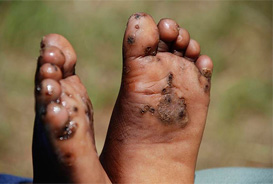
Soap used to clean the face

toothpaste used to clean teeth
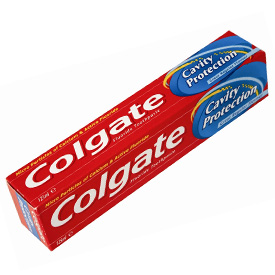
In this topic we learned about the following;
A good student changes behavour after learning new knowledge.Therefore your hygiene should have improved because you have learnt the value of good hygiene.
please revisit the topic to make sure you remember and can practice all you have learned here.
The following equipments can be used to keep the environment clean:
• Brooms

• Twigs

• Dust pan
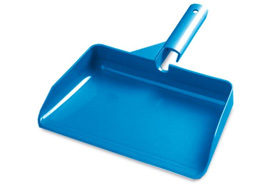
• Cleaning rug
• Bucket
• Mop
